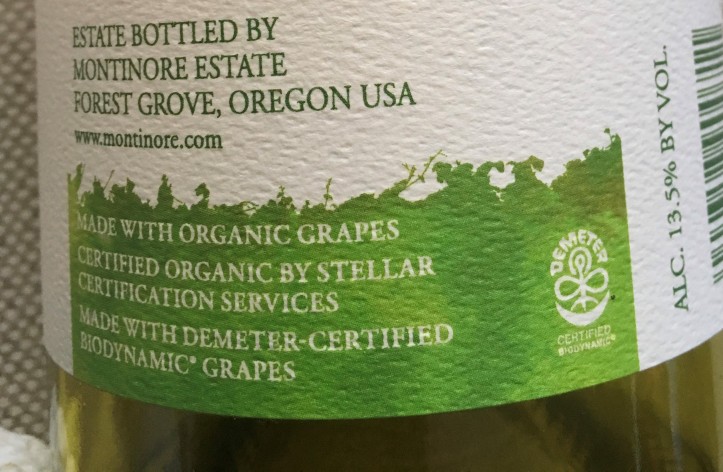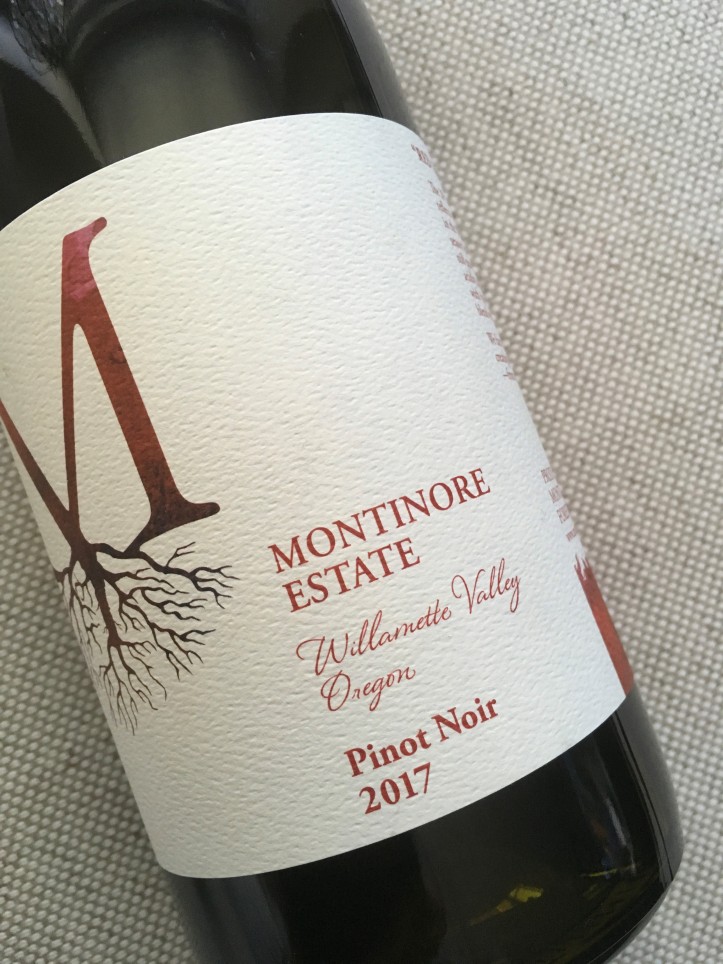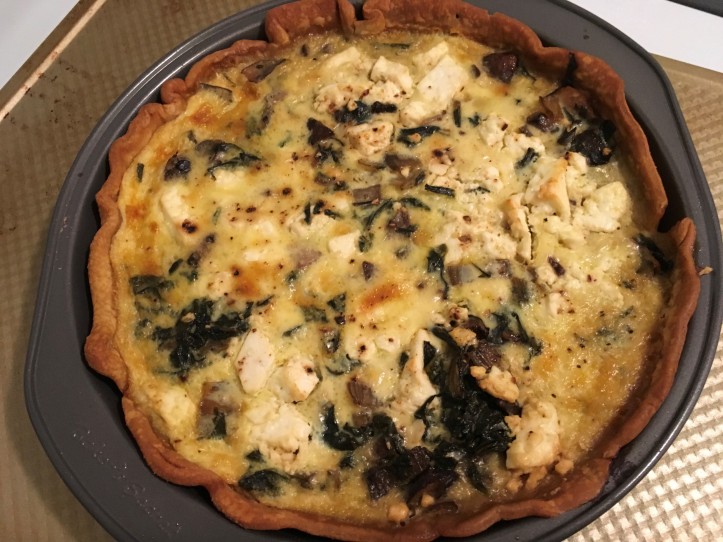
Our Wine Pairing Weekend crew is back in action this week, shining a light on wines crafted according to biodynamic principles. If you’re confused as to exactly what that means, you’re not alone: there’s been so much buzz about biodynamic, organic, and natural wines lately, it’s hard to know what’s in the bottle you’re buying.
Luckily for all of us, Gwendolyn from Wine Predator, our host this month, has sorted through the details, explaining each category and pointing out how they overlap – or don’t. Her invitation post is chock-full of easy-to-digest information – give it a read if you’d like to learn more.
And, from what I gather, several of our blogger participants will broach the subject as well. Here’s a preview of what each of us will contribute to the chat:
-
- Jeff Burrows: “Biodynamics in the Dolomites with Azienda Agricola Foradori” FoodWineClick
- Nancy Brazil: “Celebrating Biodynamic Viticulture with Montinore Estate Pinot Noir ” Pull That Cork
- Nicole Ruiz Hudson: “Organic/Biodynamic/Natural: WTF Does It All Mean ?????” Somms Table
- David Crowley: “Beef and Lamb Tagine with a Special Wine from Lebanon” Cooking Chat
- Martin Redmond: “Beautiful Biodynamic Bubbles: Quartz Reef Méthode Traditionelle Brut” ENOFYLZ
- Pinny Tam: ”A Wine Lover’s Game Plan in Drinking Well (Biodynamic/Organic/Vegan Wines & Supplements)! #WinePW” in Chinese Food and Wine Pairing
- Lauren Walsh: “A Bottle of Red; A Bottle of White – Montinore Estate Biodynamic Wines with Dinner Tonight” The Swirling Dervish
- Linda Whipple: “What’s in a label? Separating the certified Biodynamic wine from the wannabees” My Full Wine Glass
- Wendy Klik: “Wine for Earth Day” A Day of a Life on A Farm
- Gwendolyn Alley: “Going Biodynamic during Earth Month with Narrow Gate and Beaver Creek” Wine Predator
- Jill Barth: “Bodegas Krontiras: A Biodynamic Expression of Mendoza” L’Occasion
- Camilla Mann: “Seabass Agli Agrumi + Wine from America’s First Demeter-Certified Biodynamic Winery” Culinary Adventures with Camilla
Speaking of the chat, it takes place this Saturday, April 13th, at 11 am ET. If the topic of biodynamic wines has piqued your interest, please join us on Twitter and listen, learn, and chime in with your own opinion. Simply follow the hashtag #WinePW, and make sure to add it to your tweets. Hope to “see” you there!

The Montinore Estate
Established in 1982, Montinore Estate is the largest producer of biodynamic, estate-grown grapes in the United States. The 200-acre swath was certified by Demeter USA in 2008, and includes parcels planted to a host of grapes, many of which are well-known in the Willamette Valley (Pinot Noir, Pinot Gris, Riesling, and Gewurztraminer) and others that are less customary (think Müller-Thurgau, Lagrein, Teroldego, Muscat, and Sauvignon Blanc.) While their focus is on biodynamic methods, not all of the wines made by Montinore Estate are made in accordance with them.
The traditional Italian varieties make more sense when you understand proprietor Rudy Marchesi’s background: he is the grandson of Italian immigrants. Family meals – from simple weeknight suppers to gala celebrations – revolved around good food, good wine, and good friends. He fell in love with Oregon wine country, believing it had potential to grow the grapes he remembered from childhood as well as those he had come to appreciate as an adult.
In 2006 Marchesi met Stephen Webber, now Montinore Estate’s head winemaker. They bonded over their shared passion for the cool-climate white wines crafted in Alsace, France, and Alto Adige, Italy. Together they saw promise in the east-facing slopes of the Coastal Range foothills, located in the northern Willamette Valley. As a team, they turned dreams into reality, planting the varieties best suited to the land, and implementing sustainable vineyard practices, including dry farming. Shortly thereafter, Montinore Estate sought organic and biodynamic certification.

The Wines
2016 Montinore Estate Willamette Valley Biodynamic Pinot Gris (13.5% abv; $16 retail)

100% Pinot Gris from seven different plots representing the varied soils and aspects of the vineyards. Fermentation took place in stainless steel tanks with both cultured and indigenous yeasts. Some of the wine was aged on the lees to bring additional complexity.
Color: A beautiful gold, with just a hint of pink; paler at the rim.
Nose: Medium aromas of ripe pear and golden apple; notes of lemon peel and fresh herbs.
Palate: Dry, with medium intensity flavors of yellow peach and pear; medium acidity and body; long finish with flavors of ripe melon, wet rocks, and almond.
Verdict: This is a lovely wine for sipping or for pairing with light fare. Don’t drink it too quickly – you’ll want to give the aromas time to evolve in the glass.
2017 Montinore Estate Willamette Valley Red Cap Pinot Noir (13.8% abv; $24 retail)

Note: this wine is not produced via organic or biodynamic methods. I chose to include it in this post because I wanted to feature both a white and a red wine from the same producer with my pairing. The Red Cap Pinot was the sole Montinore Pinot Noir available to me.
100% Pinot Noir primarily from plots on Laurelwood soil but some grapes were grown on volcanic or marine soils. The wine was matured for nine months in a mix of Hungarian and French oak, 21% of which was first-use.
Color: Medium ruby, paler pink at the rim.
Nose: Medium+ aromas of sweet red cherry, ripe plum, and a hint of vanilla; after some time in the glass, there’s a touch of unsweetened cocoa powder in the mix.
Palate: A mix of red berry fruit, some tart cherry, and a bit of vanilla and toast. Herbal notes of mint and thyme. Acidity is medium+, tannins are silky, and the finish is long, with lingering notes of black cherry and cocoa.
Verdict: A restrained-style Pinot, with lots of fruit yet ample acidity to balance it. There are also some earthy notes that weave in and out, making this a wine of texture and nuance. It was a hit with our pairing, and I imagine it would be a great partner with a wide range of foods.
The Pairing: Mushroom and Swiss Chard Tart

I adapted a recipe from Ottolenghi: The Cookbook, which called for Jerusalem artichokes rather than mushrooms and recommended making your own dough. Whole Foods had none of the former; I had no time for the latter. Because I was pairing the dish with a Pinot Noir, I opted for baby portobello mushrooms as a substitute. And I bought a pre-made pie crust that was ready to bake.
Swiss chard is one of my favorite vegetables – I love the earthy flavors that make it seem almost meaty. Put together with the mushrooms, chunks of feta, and a mélange of crème fraîche and cream (with rosemary, salt, and pepper) the tart was delicious and filling. As an accompaniment, I tossed fresh arugula with lemon juice and olive oil.

Verdict: Both wines paired admirably with the tart, but the Pinot Noir was a home run! The mushrooms and chard brought out similar earthy notes in the wine, and the tart acidity in the wine made for the perfect palate refresher. Rich as it was, the tart needed that in a partner.
If you haven’t yet explored the lovely recipes of Ottolenghi, I highly recommend you dive in. It’s my go-to reference when I want to get creative in the kitchen – try a new ingredient or an unexpected combination of them.
Wine Pairing Weekend
We’re a group of wine-loving foodies – or maybe food-loving winos – who gather on Twitter the second Saturday of each month to exchange tips on food and wine pairings centered on a theme. Next month Jade Helm from Tasting Pour will host as we delve deeper into the world of biodynamics, with a special focus on Biodynamic Wines from Willamette Valley, Oregon. Stay tuned for her preview post!
Learn something new today. Didn’t know that the largest biodynamic wine producer is in Oregon. The pairings are spot-on. The Montinore Estate Pinot which has all the herbaceous notes must go so well with the mushroom swiss chard tart.
LikeLiked by 1 person
I learned a lot while writing this post, too! The #winepw group always offers great topics for discussion!
LikeLike
[…] Lauren of The Swirling Dervish: A Bottle of Red, A Bottle of White: Biodynamic Wines from Montinore Estate with Dinner Tonight […]
LikeLike
Hopefully, I will be home during this chat, as my sister lives in Oregon and I am partial to Willamette Valley wines! Cheers!
LikeLiked by 1 person
It should be an interesting chat – biodynamic wines always stir up lots of conversation! Sorry to miss it but will be in class from 10-6. Ugh!
LikeLiked by 1 person
[…] Lauren of The Swirling Dervish: A Bottle of Red, A Bottle of White: Biodynamic Wines from Montinore Estate with Dinner Tonight […]
LikeLike
I’m a long-time fan of Montinore Estate, we visited them on our very first trip to the Willamette Valley way back in 2011. That tart looks really delicious and I have some local feta in the fridge, just waiting to be used. Maybe this week!
LikeLiked by 1 person
Cool! Let me know what you think; especially if you have the Ottolenghi cookbook and make it with sunchokes.
LikeLike
This tart looks both healthy and decadent, if such a thing is possible. Pinot is a great choice – just the right body and earthiness. Go, Oregon!
LikeLiked by 1 person
Thanks Linda! It was delicious and decadent. Would make a great brunch or luncheon dish.
LikeLike
I was very pleased with my choice from Williamette. I will have to keep an eye out for wines from Montinore.
LikeLiked by 1 person
They’re pretty easy to find, which helps.
LikeLike
Mmmm. Your description of both the food and wine had my mouthwatering a little extra this time around. Beautiful. I too love Ottolenghi for inspo! Such wonderful cookbooks.
LikeLiked by 1 person
Thanks! It’s always fun to conduct experiments in the kitchen, especially when they’re successful!
LikeLike
[…] Walsh: “A Bottle of Red; A Bottle of White – Montinore Estate Biodynamic Wines with Dinner Tonight” The Swirling […]
LikeLike
I’ve had a bubbly from Montinore, but not this lovely red. Lauren, there is so much to taste and try! How will we do it all?
Great post as always, thank you!
LikeLiked by 1 person
If and when you figure it out, please let me know! Every month my to-try and to-visit lists get longer and longer. Happy Easter!
LikeLiked by 1 person
Loving your pairings Lauren! We off to Willamette Valley next month! Will have to look for Montinore! Thanks for the intro!
LikeLiked by 1 person
Thanks Martin, I had a lot of fun dabbling in the kitchen a bit this month. Enjoy your trip to the WV; can’t wait to read all about it!
LikeLike
What a great post! We had such a wonderful time spending a morning with Rudy last summer. He is a wealth of knowledge and so passionate about biodynamic farming.
LikeLiked by 1 person
Thank you Robin! I’d love to get to Montinore in person one day – the wines were so enjoyable.
LikeLike
Was disappointed to find out that the Montinore “Red Cap” pictured and featured in your article is neither organic or biodynamic (and is also apparently one of their highest production wines). A shame to see the effort promoting and advertising their BD program, when noticing now, a significant percentage of their wines are not biodynamic at all. I’d hope you let your readers know of this, as it is somewhat misleading. Such a disappointment, and I hope to see more wineries in the future featured for their dedication and integrity with this very special BD philosophy both in the vineyard and winery. Thank you for your blog, I really do enjoy it!
LikeLiked by 1 person
Thank you, Lisa Anne, for reading my post and taking time to comment. You are correct that the post was unclear about how the Red Cap Pinot Noir was produced (i.e., not via biodynamic methods.) I have made several edits – including to the title – to clarify this point. I appreciate the feedback and the reminder to be more precise in how the information in each blog post is presented.
LikeLike